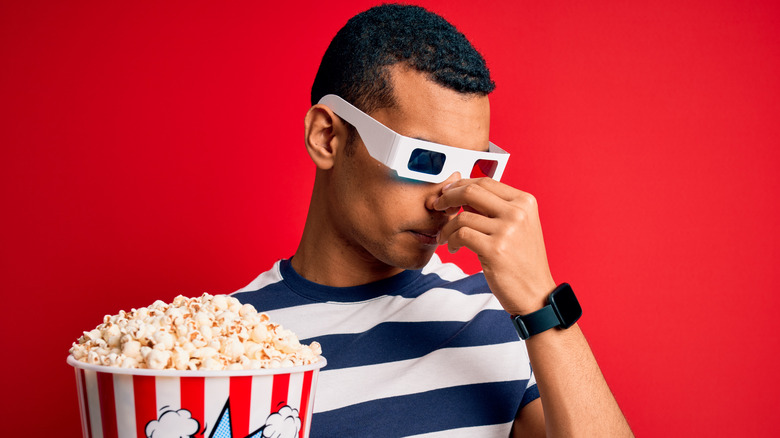What Happens To Your Body When You Watch A 3D Movie
The creative team behind any movie works tirelessly to ensure that the on-screen story comes alive for viewers. Actors do so by creating characters, writers develop exciting storylines, and special effects artists enhance the audience's experience by making fictional worlds look realistic right before our eyes. With the creation of 3D movies, moviegoing now feels more interactive than ever. How is this possible — and what happens to our body when we slip on those red and blue cardboard glasses?
To understand how 3D movies affect the body, we must first understand how 3D images work. The goal of a 3D movie is to simulate the natural way in which our eyes take in the world around us (via Science ABC). The reason why we see our everyday surroundings in 3D is because our brain blends the two different 2D images taken in through each of our eyes to create one picture. Once combined, a sense of depth is created, giving us our three-dimensional world.
Just like our two different eyes, film crews utilize two different camera lenses to create this variation in depth perception. With the help of editing software, the 2D images taken from each lens are merged, thus creating a 3D effect.
3D movies can cause eye strain, headaches, and nausea
If this sounds like a lot of work for your eyes, you would be right. According to experts at the Silverstein Eye Centers, watching a 3D movie forces the muscles in each eye to work independently of one another, rather than in unison. This can result in eye strain due to fatigue, and for some, disorientation.
Additionally, it's not uncommon for some people to experience headaches or nausea while viewing a 3D movie. This is due to the fact that during the movie, the brain is grappling with an intake of contradictory information and attempting to make sense of it (via Live Science). On the one hand, the film tells us we are in motion, but the part of our body responsible for balance is not sensing movement. When the brain receives these opposite messages, it can leave us feeling dizzy or physically ill.
While eye damage from 3D movies is unlikely, Silverstein Eye Centers states that giving your eyes periodic breaks from the screen can help reduce discomfort. By focusing your eyes elsewhere, you will help restore the brain's natural sense of balance. Those with preexisting conditions affecting their vestibular system may be more susceptible to headaches when watching 3D movies. Therefore, medical professionals also advise sitting further back in the theater to create more distance between you and the screen.


